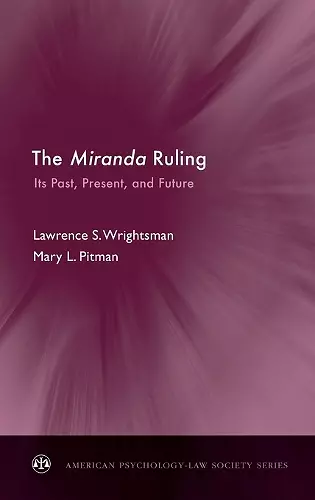The Miranda Ruling
Its Past, Present, and Future
Lawrence S Wrightsman author Mary L Pitman author
Format:Hardback
Publisher:Oxford University Press Inc
Published:29th Jul '10
Currently unavailable, and unfortunately no date known when it will be back

Where did Miranda go wrong? The purpose of this book is to identify and describe four problems with the implementation of the Miranda decision and to suggest remedies in order to have it achieve its original purpose. The four problems identified in the book are: 1. The justices, in placing restrictions of the questioning of suspects, limited these rights only to those suspects who were "in custody." The term "in custody" is legally vague as well as vague to the layperson. It permits the police to question suspects without giving them their Miranda rights in those settings where it is unclear whether custody is present. 2. The Miranda warnings may not be fully understood by many suspects. There is no country-wide standardization of what is said; there are literally thousands of different versions of "the" Miranda warnings in use by different police departments in the United States. 3. Police training manuals, while recognizing the right to a "Miranda warning," have developed many ways to circumvent giving the warnings or ignoring a response in which a suspect does decide to remain silent or ask for an attorney. 4. In the 40 years since the Miranda law was established, the Supreme Court and lower courts have made decisions eroding their application. Can the original goal of the authors of the Miranda law be salvaged? This book examines the state of interrogations and the state of the law before the Miranda decision was made, the purposes and nature of the decision, and proposes recommendations for reinstituting the original goals.
"The Miranda Ruling: Its Past, Present, and Future is not only a useful primer for people unfamiliar with Miranda's antecedents and progeny, but it also makes a significant contribution to the literature by explicitly applying psychological expertise to understanding how Miranda came to be and how this decision has shaped interrogation practices...Lawyers wishing to augment their legal understanding of voluntariness with an introduction to the psychological literature pertinent to whether a confessor was coerced will, therefore, also find this work helpful. Graduate students interested in interrogation specifically or the accommodation of competing considerations within our justice system will also find it informative." --PsycCRITIQUES
ISBN: 9780199730902
Dimensions: 157mm x 236mm x 18mm
Weight: 431g
208 pages